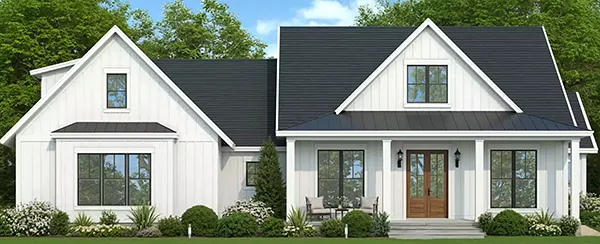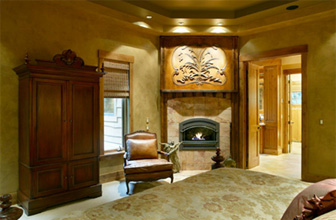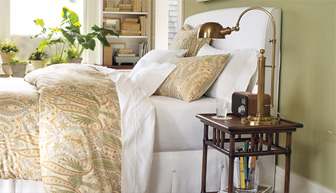Covering Your Walls with Color
Considering how color makes you feel and what it says about you, is it any wonder that color is one of the most important decorating decisions you'll make when designing your new home. It's a good idea to check out the latest trends in color and painting techniques before you decide on your color scheme.
This gorgeous master suite features walls that are done in
American Clay®, which is an eco-friendly earth plaster. It's shown in the
Loma™ collection, which has a charming and rustic feel. View all the interior rooms in this
Craftsman home.
According to the American Society for Interior Design (ASID) homeowners choose comfort shades such as red, which is very popular for the dining room, and soft blues and lilacs, which are serene. Once you pick a shade for each room you can begin to create an environment that truly represents your personality and tastes. Color is known to have psychological effects, so you'll want to choose your colors carefully. The "warm" shades on the color wheel, including red, orange, and yellow, will make a room energetic and welcoming, and stimulate the appetite; the "cool" colors, such as blues and greens, are conducive to relaxation and sleep. This may be why red, for example, is so popular in dining rooms and blue finds its way into many bedrooms. Consciously or unconsciously, we tend to gravitate to colors appropriate for our emotional needs in our rooms.
Don't overlook neutrals as you are choosing your colors. Neutrals are browns, tans, grays, whites, and blacks. These colors help to balance the space and other colors in your home.
There are hundreds of variations on the color white and it is a favorite on home walls. White can have the slightest tint of any warm or cool color to give a nice creamy color to keep the walls light.
Regardless of what color you choose, test it first. Colors can look much different once they are on the walls. Test at least a one-foot section before doing the whole wall. Paint will be the lowest cost wall covering you will most likely find.
Benjamin Moore® Pottery Barn® Collection of paints feature a charming new color palette of inviting hues and rich neutral color tones to give your home a beautiful and harmonious look. Shown in Olive Branch.
Faux Finishes
Faux is French for false, and faux finishing is used to make surfaces and objects look distressed and aged. It is also used to mimic materials like stone, marble, wood, and leather. When using paint as your wall covering, faux finishing can add the view and texture you want to spruce up your rooms. These techniques can be a bit difficult, so it may be a good idea to request a sample board and work closely with the artist so you know what you are getting. Faux finish prices vary depending on the size of the room, labor, and the amount of detail. If you would like to try this yourself, you can find the materials you need in a high scale paint or hardware store. Some of the materials you will need are brushes, finishing tools, cheesecloth, stencils, trowels, and wood graining tools. The old technique of using a sponge and rag are no longer used.
Faux finishing is completely unique and custom. Every finish is different. It is also very durable. The technique is done on eggshell base coat with washable paints, so clean up is easy.
Really Know Your Colors
It can be fun choosing your home colors. It can also be very rewarding if you know the basics on choosing your palette. Knowing a little about the basic color codes can be very helpful.
- Color affects mood and emotions.
- Colors are broadly divided into two categories - warm and cool.
- Warm colors (red, orange and yellow) make us feel warm in a psychological way.
- Cool colors (blue, green and purple) convey peace and relaxation.
- Colors have psychological meanings. Understanding them can help match each room's colors to a personal taste and the room's purpose.
- Color can change the perceived size of a room. To make a room seem larger use a light color scheme.
When selecting a new color scheme, bring home a variety of samples to view. Stick a color chip to your surface and look at it at different times and in different weather. Changes in light can give the same color many different looks.
Design Tip
There are many green alternatives to painting your walls. You can try wet-applied products such as plaster, glazes and stains; adhesive-applied products like wallpaper and textiles; or even hard surface materials like wood paneling, stone veneer or tile. Whatever wallcovering you choose, be sure to use low- or no-VOC glues and sealants. Most textile or paper wallcoverings have an adhesive backing. Paper is commonly used as a backing, which is a much greener option than PVC backing.



.png)
.png)



